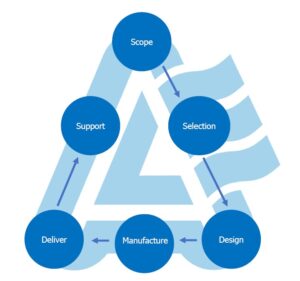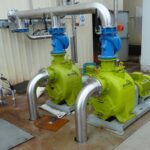Liquids and fluids are transferred at high temperatures in almost all industries. Understanding the impact of hot liquids on your pumps will help you ensure the long-life of your industrial pumps. Using a standard pump to transfer liquids and fluids at high temperatures can lead to various problems like: Leaking seals and damaged drives. Or even pump breakdown.
Here are some typical applications where pumps handle liquids and fluids at high temperatures.
| Type of Liquid/Fluid | Description of the Process | Examples |
| Solids at room temperature | Sometimes materials that are solids at room temperature are heated to move them quickly. | molasses, asphalt, palm oil, tallow |
| Liquids that are heated during a specific process | Sometimes liquids are heated to initiate, accelerate, or sustain a specific reaction. | Thermal transfer oil, cooking oil, boiler feed, steam condensate |
The temperatures of the liquids/fluids vary significantly. It can range from 110◦C to 400◦C. Let’s look at how liquids and fluids at high temperatures impact industrial pumps.
Effects of High-Temperature Liquids on Pump Externals
The external parts of an industrial pump are those that are visible from the outside. On the outside, these parts are subject to external weather conditions. On the inside, these parts come in contact with the hot liquid/fluid.
Choosing the right external part for a pump depends on the following: Corrosion resistance and dimensional changes due to thermal expansion, thermal shock resistance, etc. Thermal shock occurs when the pump’s external parts are subject to sudden changes in temperature. The temperature of the outer parts is subject to sudden changes. For example, water is sprayed on the external casing of pumps that handle hot oil to reduce the temperature. Similarly, multiple industrial applications let pre-heated liquid into a cold pump. The chosen external material must be able to sustain thermal shocks. Selecting a material that is not resistant to thermal shocks can lead to cracking of the pump externals.
Here are some of the standard pump exterior materials and their capability for handling thermal shocks:
Cast Iron – It’s commonly used for pumps that handle hot liquids. However, it has low thermal shock resistance and can only handle liquids up to 345◦C.
Low Carbon Cast Steel – It has high thermal shock resistance and can easily handle liquid temperatures up to 425◦C.
Effects of High-Temperature Liquids on Pump Internals
Besides the external parts, the internal pump parts must also be suited to handle high temperatures. When it comes to internal parts selection, the effect of thermal shock is less of a concern. This is because the internal parts are generally not subject to sudden temperature changes like external parts. The crucial factor to consider while choosing internal parts for pumps that handle high temperatures is dimensional change due to thermal expansion. The reasons why this factor is critical are: Pump clearances play a crucial role in determining the maximum efficiency of the pump. The high temperature of the pumped liquid causes the internal metal parts of the pump to expand. This reduces internal clearances causing a drop in pump efficiency. While choosing a pump that will routinely handle liquids at high temperatures, you need to ensure that it has extra internal clearance. The thermal expansion rate varies depending on the material used.
Effects of High-Temperature Liquids on Pump Seals
Seals play a crucial role in ensuring that the liquid stays within the pump. The part of seals becomes more critical, especially when handling liquids at high temperatures. Mechanical seals are used in pumps for the following reasons: They are leak-free. They do not require external lubrication. They are easy to replace. They minimise shaft wear. They do not require external adjustments.
Selecting the right seals depends on the temperature of the pumped liquid.
Here are a few factors to consider: The maximum temperature of the pumped liquid. Compatibility with the pumped liquid. Quenching or seal flushing is carried out to cool down the external seal faces and reduce residue build-up. Besides the seal material, another factor to consider is the seal placement. By placing the seal down the shaft, away from the internal pumping chamber, the seal’s temperature can be reduced by nearly 40◦C.
The Bottom Line Operating a pump with liquids and fluids at high temperatures requires special considerations. However, note that no two pump applications are the same. So, if your industry needs liquids and fluids to be pumped at high temperatures, get in touch with our sales team here at Allflo.
Send us a quick email to sales@allflo.com.au stating your requirements, and we’ll help you find the perfect fit for your needs.
Allflo Pumps are one of the leading suppliers of pumps and pump accessories.
With over 70 years of combined of experience, and a manufacturing plant in Shepparton, Victoria, Allflo Pumps and Equipment has a large range of quality pumps and equipment engineered to suit a variety of requirements across infrastructure, construction, water treatment plants, mining, food industry for all types of buildings including commercial enterprises and more.




























































































